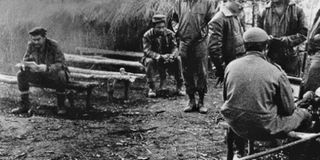How Kabila delayed Tutsi return to Rwanda

Revolutionary freedom fighter, Ernesto Che Guevara (L) at a camp in a Congo forest from where he and his forces helped the Tutsi fighters in 1965.
What you need to know:
In Part II of the series, we look at how the Tutsi tried to stage a military incursion from Congo, with the help of Che Guevara and how it failed.
It can be said that former Congolese rebel leader Desiree Kabila in the 1960s, and later president of the Democratic Republic of Congo, delayed the Tutsi refugees return from exile. His indecision denied the Tutsi the earliest opportunity to return.
For more than 30 years, Rwandese refugees anxiously waited for the day they would return home. Had the Congolese rebel, Kabila, acted as a pan-Africanist and a spirited revolutionary freedom fighter, the Rwandans would have returned home probably by the mid-1960s.
If Kabila had not frustrated the world’s famous revolutionary freedom fighter, the Argentinian-born Ernesto Che Guevara, who had with Cubans pitched a military camp inside the Congo forests, and who were already in contact with and in support of the Tutsi refugee rebels cause to return, chances are that the regime of president Gregoire Kayibanda of Rwanda would have failed to militarily stop their return mission.
After the 1959 rebellion against Tutsi dominance, the Tutsi in camps inside Tanganyika (Tanzania), Uganda, Burundi and Congo, were assured of military assistance from Communist countries to fight their way back home. In fact, they got enough weapons.
In the book, Che In Africa, which includes some letters and memoirs of Che authored by William Galvez, also a Cuban fighter in Congo, Galvez on page 96 wrote: “We spent June 24, 25 and 26 cleaning Rwandese guns; and some [s]till had grease put in from the factory”. There were more than 200 Cuban fighters and an unmentioned number of Rwandan fighters who spent three days cleaning the guns in preparation for the July 29, 1965, battle at the Front de Force garrison.
In the 1960s and 1970s, Tanzania was the “Conference Hall” for the world’s revolutionaries and freedom fighters, where they convened to plan how to propel military liberations across Africa. Kabila was one of those there. During his stay there, contacts were established with Cuba and a military plan to defeat Americans and Europeans in Congo was drawn. Little did Che, and the Rwandan rebels know, that Kabila would prematurely end their dreams.
Che arrived in Congo in April 1965 to join the Cuban fighters but he was to return to Cuba in February 1966 disillusioned. His departure partly deflated the Tutsi’s return mission, at least from their Congo base. Kabila was the kind of rebel leader who “fought” from the lavish hotels of Tanzania.
Indeed, his style killed the Cuban Mission and the Tutsi Return Vision in Congo. Galvez, in his book says having arrived in Congo, Che waited for months for Kabila to come to the front to plan the execution of the war, but Kabila kept sending letters, saying he would come soon. He finally did, but was afraid to go to the battle field to observe the situation. He even didn’t want Che to go to the front line. A frustrate Che requested Kabila to inform the Tanzanian president, Julius Nyerere, of his presence in Congo, but Kabila refused.
Indeed, the majority of fighters for the liberation of Congo were foreigners. On page 97, Galvez wrote: “It is strange that Che didn’t realise that the Rwandan and Cuban internationalists [mercenaries] were the largest forces that went into battle. The Congolese leaders didn’t risk many of their own men.” With much frustration and a great loss of fighters, the Rwandan mercenaries decided to pull back.
The author further reveals on page 110 under the chapter titled: ‘Rwandans blame the Congolese’ that, the Rwandan commander sent many letters to Che complaining that he wouldn’t have any combatants left for carrying out the revolution in his own country, because many men had been killed in the last action, including his best cadres. “The Rwandan commander lamented that he had been planning that once Albertville had been taken, he would return to his own county to begin the struggle; but with so many losses in his ranks, it would be impossible,” Galvez wrote.
Nonetheless, the author also reprimanded the commander on same page and wrote: “He [Rwandan commander] blamed the Congolese for everything, ignoring his own mistakes, including that of keeping his troops separated from the Congolese.” Finally, when the war was lost, some of the Rwandans scattered in East African and the world in general while some came to Uganda and joined the armed forces.
The Rwandans would have to regroup to get back into their country.
Demoralised fighters
Desiree Kabila’s (pictured) actions depleted the morale of the fighters, especially the Rwandans, who vowed never to fight alongside their Congolese counterparts against Moise Tshombe’s forces. Soon, disagreements emerged between the Congolese and Rwandan rebel forces.
Che’s effort to re-organise the rebel command structure yielded less as Rwandans started to resent the Congolese and vowed only to engage the enemy if Congolese too went to the front line. Soon after, many deserted the war as the Congolese were always running away from the enemy fire. A Ugandan veteran of the Katanga war, retired sergeant Stephen Ssempagala aka Kifulugunyu remembers the war as if it happened only the other day.
Because Kabila, the Congolese rebel leader and also the go-between, was in Tanzania, Che’s attempt to unite the Rwandans and Congolese as a single force failed. On page 136 Galvez quotes Che as saying: “I urged them [Rwandans] to unite with them [Congolese] reasoning that the outcome of the struggle in Rwanda depended on the struggle in the Congo, since it involved a greater confrontation with imperialism.” It is likely that the distrust between the two rebel groups would have been averted if Kabila had had the charisma to fight and win.




